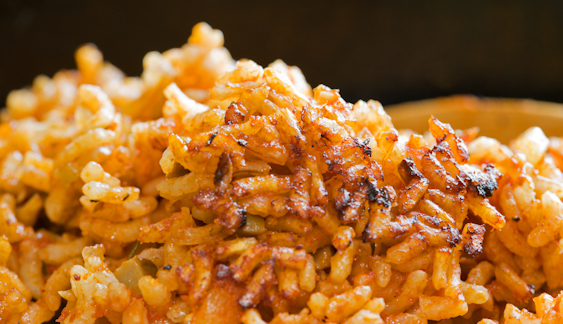Savannah Red Rice

introduction
A rebuke to the legions of bad recipes in its name, this red rice comes out of the pot swirling with agreeable contrasts: cool bay, hot spice, warm tomato, light smoke. If you get lucky, it will have a fine, crisp bottom crust and the grains of rice on top will be plump, separate, and drunk with flavor. (The rice will be plump, separate, and drunk even if the crust doesn’t happen.) Minced mushrooms and a dash of vinegar stand in for the historically correct mushroom ketchup and represent a distinct improvement over the sweet tomato ketchup present in many recipes today.
A pilau, Savannah red rice stands as a defining dish of the Georgia Coast. Red rice is so rich in influence it is hard to know which version of this dish to consider and where to begin. As far back as the Inquisition, Sephardic Jews fleeing Spain and Portugal arrived in Savannah, bringing connections to Mediterranean foodways (especially when it came to rice) that have endured to this day. In their emphasis on vegetables, herbs, and spices, these rice dishes often reduced meat, fish, poultry, and game to condiment status—with magnificent results.
Given this history, we might expect to experience good—even great—red rice today. Yet red rice is more institutional than inspired. At its best, Savannah red rice is scintillating in its flavor dimensions. The inclusion of pork in this dish shows elements of colonial creolization, probably African or French. The addition of mushroom ketchup (a condiment), with its dark, woodsy, vinegar notes, comes from 18th-century Britain by way of colonial India.
Cooking Remarks
The “do not disturb” period at the end of cooking, known in the 19th century as “soaking,” is designed to give the rice grains a few minutes to compose themselves and help them resist breakage when they’re spooned and served. Don’t skip this step.
Our favorite tomato product for this dish is produced in Italy by the company Bionaturae. It comes in a jar and is called Organic Strained Tomatoes. A flowing, smooth, guileless sauce with a clean, forthright taste, this product is simple perfection. You may also use tomato juice or
a comparable volume of canned tomatoes that have been pureed in their juices and passed through a strainer.
equipment mise en place
For this recipe, you will need a small nonreactive saucepan, a wooden spoon, a well-seasoned 8- or 9-inch cast-iron skillet with lid (or other similarly sized rondeau), a stainless steel medium-fine-mesh strainer, and a couple of pieces of aluminum foil to wrap around the skillet lid for insulation.
-
-
1cup Rich Homemade Chicken Stock or low-sodium boxed broth
-
1cup Bionaturae Organic Strained Tomatoes (see Cooking Remarks) or tomato juice
-
2teaspoons red wine vinegar
-
1Turkish bay leaf, crumbled
-
2small whole chipotle chiles in adobo sauce
-
2ounces smoked sliced bacon, diced fine (¼ cup)
-
1small yellow onion, minced (½ cup)
-
¾teaspoon dried thyme
-
1teaspoon fine sea salt
-
½teaspoon freshly ground black pepper
-
1celery rib, diced small (⅓ cup)
-
4ounces small button mushrooms, diced fine (1 cup)
-
1garlic clove, minced
-
7ounces (1 cup) Anson Mills Carolina Gold Rice, rinsed and drained
-
-
Pour the stock and tomatoes or juice into a small nonreactive saucepan. Add the vinegar and bay. Drop the chiles (and any adobo sauce clinging to them) into the pan and mash them against the sides with a wooden spoon. Cover and bring to a simmer on low heat to infuse the flavors, and then remove from the heat.
-
Set a well-seasoned 8- or 9-inch cast-iron skillet over medium heat. Add the bacon to the cold pan and sauté, stirring, until crisp, about 5 minutes. Add the onion and thyme and sauté until golden, stirring frequently, about 5 minutes. Stir in the salt and pepper. Stir in the celery and cook until barely tender, and then increase the heat. Add the mushrooms and cook until they release their juices and the juices have evaporated, about 2 minutes. While the mushrooms are cooking, bring the stock mixture back up to a simmer. Have a stainless steel, medium-fine-mesh conical strainer and a 9-inch lid wrapped with aluminum foil—to assist with the seal—at the ready. Stir the garlic into the vegetable mixture and sauté until its aroma blooms, about 10 seconds.
-
Stir the rice into the vegetables and sauté until the grains are opaque, about 30 seconds. Pour the hot stock through the strainer into the skillet, pushing with the back of a wooden spoon to get every bit of liquid into the rice. Stir the rice, cover tightly with the foil-wrapped lid, and turn down the heat to low. Cook for 20 minutes without lifting the lid, and then remove the skillet from the heat. Let rest for 10 minutes before uncovering and serving.